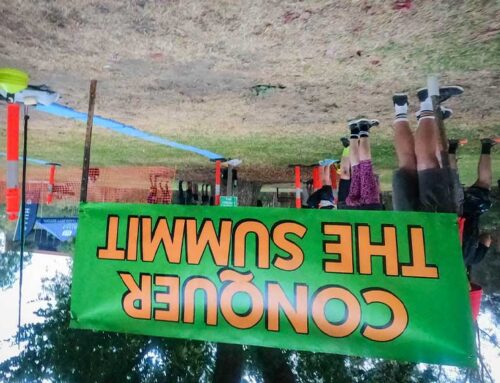How often have you caught yourself saying “I’ve always wanted to do that” or “I’ve always wanted to go there” but never really stopped to think about what it would take to make it happen? For me personally, I do it all the time. Whenever someone would mention Uluru, or I’d be overseas and someone would ask me if I’d ever been, I’d say something like “Oh yeah, I really want to go there”. Which is a nice throwaway answer, but the reality is, if I’d really wanted to go there, I probably would have gone by then. So one day, rather than make excuses, I just hired a car and went. I didn’t need any special skills or knowledge. I didn’t need a million dollars. I barely even needed a map as there’s pretty much just one big road straight up the middle of Australia so it’s not easy to get lost along the way. No, all I needed was a hire car, money for a few tanks of petrol, a few extra bucks for food, somewhere to pitch my tent, and a decision. This wasn’t akin to the preparation and budget required to climb Everest. I hadn’t gone simply because I hadn’t made it a priority. It turns out it was really only the ‘decision’ part that had been stopping me from doing this thing I apparently “really wanted to do”. (Quick note: if you’re planning on taking a hire car to central Australia, make sure you check if that is allowed as most companies won’t let you take hire cars into certain places including remote areas. Something I only discovered when I went to pick my car up, which required quite a bit of frantic hustling in coming up with a Plan B. But got there eventually. Thanks Europcar.)
Adelaide to Uluru is a 1600km drive. Even further if you go to Alice Springs ‘on the way’ as I did, which then requires an almost 500km back track. This gave me plenty of time to take in the outback surrounds and spend time with my thoughts. I’d often considered whether I would or wouldn’t climb ‘The Rock’, and the truth is, before I left, the jury was still out. It’s easy to say what you would or wouldn’t do if or when, but until you face your moment of truth, you can never be sure. On one hand, the traditional custodians of the land didn’t want tourists climbing it. On the other, they didn’t actually ‘own’ the thing, and their beliefs were different to mine, so surely they could have their beliefs and I could have mine? Besides, I love a good adventure and after sketching out of climbing Half Dome in Yosemite the previous year, I quite liked the idea of climbing something.
But a funny thing happened on the drive on the way up. If I said I had a bit of epiphany, you’ll probably think I’m a bit of a wanker. But it’s the only way I can think to describe it. When you spend time in the outback, and I don’t mean flying over it, or visiting a specific place, but actually walking through it, sleeping in it, and driving through it for hours and hours on end and taking in the surrounds, it’s difficult not to have… a moment. One of mine, was when I passed a fence, just out there in the middle of all that… vastness. A fence. We see them everywhere in urban and regional areas and think nothing of it. But I looked at the fence and couldn’t help but think how absurd it was that someone had turned up, and probably quite arbitrarily, just built a fence and called that bit of Australia theirs. Don’t get me wrong, I get it. I know how ‘settlement’ works. But when you’re out there, and you see fences in those wide open spaces where someone has decided to claim it for themselves, if you truly stop and think about it, not through the filter of our current life experience and culture, but just the notion of it, it truly can’t not strike you as being slightly… odd. And possibly even, dare I say it, unnatural. And that was my first moment.
The second one was when I first drove into Alice Springs. And please forgive me for re-telling this story, but I’m having faith that you’ll understand what I’m trying to explain without thinking less of me. As I drove into the city of Alice Springs, I noticed a small group of Indigenous people sitting on the side of the road. Even as I write this a year or two later, I can remember it like it was yesterday. More importantly, I remember what I said to myself as I saw them sitting there, quite out of kilter with all the signs of white settlement around them. “What the heck are they doing just sitting there?” I wondered. It was probably a fair question, considering it’s not something I’m accustomed to seeing. But from somewhere, who knows where, came the answer. “They’re doing what they’ve always done.” Bam! We may have built a town under and around them, but they were just doing what they’d always done. Sitting. Talking. Possibly enjoying their connection with the land. For all I know, they could have been discussing the episode of NCIS they’d watched the night before, but I’d had another moment. That was how it had always been for them. Perhaps what they were doing was discussing how weird it was that we’d built so many fences and then a city right under them. And fair enough.
Let’s get back to Uluru though. Had I not had a few of those moments, who knows what I might have done when I arrived. I’d like to think I would have done ‘the right thing’, but now I’ll never know. Instead, I can tell you that by the time I got there, even any teeny weeny sliver of a thought of climbing such a sacred place went right out the window. There was simply no way I could climb it. Not because I was scared of heights – which I am. Not because I was worried about my fitness – which I wasn’t. But simply because our indigenous people didn’t want me to. So I didn’t. I couldn’t.
What I did do, was watch it change colours through a wonderful sunset. And I was in awe. Then, after the crowds had gone thinking the show was over, I stayed and watched the stars come out above it. And I was in awe. The next morning, I woke early to go and watch it at sunrise. This time I picked a more out of the way place to view it, and again, I was in awe. Then I decided to do the base walk. If you’ve never been to Uluru, no amount of pictures or video can do the size of it justice. It’s about 10kms to walk around the base of it, so it is seriously gigantic. I’m not sure how big I thought it was, but not that big. So I walked around it, taking it in from all angles. And I was in awe.
I was quite surprised to see signs placed at various points, asking tourist not to take photos of Uluru from certain places. This surprised me a bit. That I could take photos from one spot, but move literally a few steps to the left and it was a big no-no. Part of that seemed a bit silly to me. But again I was reminded, this wasn’t about what I believed, it was about respecting what someone else believed. When I’m Indonesia or Cambodia and I want to visit a temple, I make sure I wear something they deem respectable. Not my beliefs, theirs. When I’m in a library or church, I talk quietly. Not my beliefs, theirs. When I don’t take photos of Uluru from certain angles, I’m not doing it because of my beliefs, but theirs. There’s a sign at the base of the trail you use to climb up Uluru too, and it requests that you don’t climb it out of respect. Not out of respect to your own beliefs, but to theirs. And it made me surprisingly angry to see how many people chose to ignore that. How could these people put a little bit of “let me conquer the rock” glory above respect for these people’s beliefs?
Not having climbed it myself, I can’t comment on what that experience is like. I can, however, assure you that viewing Uluru from a distance, up close, and walking around it, is a pretty epic experience and I don’t for a second feel like I’ve missed out on anything. Call me sanctimonious if you will, but not only do I not feel like I missed out on anything, I actually feel much better for having shown respect.
And that brings us to now. As of yesterday they’ve announced a ban on climbing Uluru effective 2019. And hasn’t all hell broken loose? Some of the reactions to this have been truly frightening. And particularly hateful. Yet again we see this whole “us versus them” mentality emerge. I’m loathe to repeat any of the comments I’ve seen on social media, but in case you think I’m over reacting, here’s just a sample… “Banning white folk from climbing any rock is as ABHORRENTLY RACIST as banning black folk from walking down Queen St. It is just plain wrong.” And this: “Can we ban aboriginals from modern civilization?”. Or how about this: “Uluru belongs to the culture that made this country what it is, not to a bunch of no hopers who have had their hand out since the first Centrelink opened”. Should I go on? Because I can. “The aborigines have always been intolerant. When they arrived here they committed genocide on the Native Pygmies who were here. When the British arrived seeking refuge from their government, they were treated with the same intolerance. They didn’t count on us defending ourselves though.” I’m not sure what history book ‘Emm’ has been reading, but “refuge”? “Defended”? That’s certainly an interesting take on it. And then ‘Melanie’ has this to say “It was known as Ayers Rock for a lot longer that it has been known as Uluru. It didn’t become commonly known by the traditional name, until the resort was built near it.”
And there it is.
“It was known as Ayers Rock for a lot longer that it has been known as Uluru.” I can only assume she is not taking into account fifty or sixty thousand years of history with that observation. Because what she actually means is, averag have known it as Ayers Rock for longer than they’ve known it as Uluru. And that’s really what this whole kerfuffle is about. Our perspective. Not theirs. Again.
To me, whenever there’s an “us versus them” or even “me versus you” element in play, I ask myself the same question: what’s it going to ‘cost’ me to make this OK? What do I have to do to show respect, and am I prepared to do it? In this case, I’m not being asked not to visit, to not walk around, to not enjoy Uluru. Just not to climb it. And for me, that’s a “yes”. Yes, I’m happy to not climb it if it’s important to you. That’s how respect works.
Then there are those who are bringing the “slippery slope” argument to the table. “What’s next? Not being able to climb Everest?” And these examples sometimes make for entertaining conversation, but the last time I checked, indigenous Australians don’t really have an issue with Everest. And if someone in that region does, who is going to be affected by that one? The handful of people with the enormous amount of money it takes to summit each year? I’m sure they’ll manage just fine as well. This idea that we’re somehow having our one shot at happiness taken away from us is just fucking absurd. This isn’t about something we can’t do any more. It’s about what we can do: we can show some fucking respect. A novel idea, I know.
So to anyone who’s still banging on about comparisons to The Vatican, or the pyramids or Everest, I don’t suppose we could all just agree that Uluru is Uluru? Not Everest. Not a pyramid. Or the Vatican. These examples make for interesting conversation, but man made or natural wonders, they just aren’t relevant. Yes, you can go into the Vatican. No you can’t go everywhere. I can go to a temple in Bali. But they ask me to dress a certain way and that women who are menstruating don’t go in. Is that a bit silly to us? Yep. But each place has its own specific culture and beliefs. So this isn’t about whether we like it or agree with or understand it. It’s about whether we’re prepared to accept and respect it. Regardless of what it is, and where it is. And it’s about what it will ‘cost’ us to respect it.
In this case, the ‘price we pay’ is to just not climb it. Nothing more. Nothing less. We just don’t climb it. It doesn’t mean we can’t go the Vatican. Or climb Everest. Just not climb Uluru. For no other reason than a race of people initially asked us not to, relying on our better nature, which apparently we didn’t have. So now they’re demanding it. Because not only is it against their beliefs for us to take that sacred path, when visitors do go up there, they piss and shit and vomit up there as well. Classy.
If people really want to climb it because it’s “just a rock”, then guess what? You still can. They’ve been gracious enough to concede that if you’re truly disrespectful enough that you simply must climb it no matter why you shouldn’t, then you’ve got two years to do it. So there’s really no need to complain or be outraged, just go climb it. But then, there’s really no need to be racist either.
Mostly, this is about one simple idea: Being kind to other humans – even when you don’t always understand or agree with them.


















